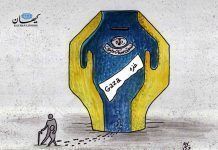December 29, 2017
Potkin Azarmehr
Something profound is happening in Iran, and the Western mass media are simply not reporting it.
For some time now, protests by ordinary Iranians have become a daily routine. The protesters include workers who have not been paid wages or have become redundant. They include savers who have lost their savings in Iran’s many quasi-banks, which are infested with corruption and embezzlement. They include people concerned about the environmental disaster that Iran is fast turning into. They include people protesting at rising prices. They include retired pensioners whose retirement funds have been plundered by successive administrations, and people on low income who can no longer make ends meet.

These protesters come from across the whole spectrum of Iranian society. The protests are getting bigger, and their chants are becoming more radical.
In the early days of the 1979 revolution which swept the mullahs to power in Iran, the protests were far less frequent. There were far fewer demonstrators in isolated religious cities, and they were ignored by the mainstream population of Iran. Yet the Western mass media never missed an opportunity to report on the smallest and most insignificant of those early protests, and created a hype that eventually gained momentum.
Thankfully today, we do not have to rely on the politically biased Western correspondents based in Iran, who seem too scared to upset the Islamic Republic and to report on anything other than good-cop-bad-cop scenarios pitting the “moderates” against the “hardliners.” Today, we have social media; every citizen is a potential reporter with a camera, and news travels faster than the foreign correspondents and “echo chambers” can say “moderates in Iran!”
In recent weeks, protesters have been chanting much more radical slogans: cries of “Death to Rouhani” and “Down with dictatorship,” and expressions of yearning for the happier days before the 1979 revolution.
Iranian pensioners in Isfahan protesting their dwindling retirement benefits chanted: “What a mistake we made, by taking part in the revolution.” And on Thursday, protesters in the holy city of Mashad chanted: “Reza Shah, Bless Your Soul,” referring to the founder of the Pahlavi dynasty, Reza Shah the Great, modernizer of Iran and nemesis of the Shia clerics in Iran.
The protesters have also been chanting against the judiciary, whose corruption and excessive powers have made them the most unpopular institution in the Islamic Republic — and that takes some doing.
Videos posted on social media clearly show society to be extremely tense. The population are angry and have had enough. Most importantly, they are not scared anymore. They openly mock the security forces, and are finding strength in their numbers.
On top of these protests, there is the new phenomenon of Restart, initiated by a popular former game show host on Iranian State TV, Seyed Mohammad Hosseini, who is now in exile in America. The former host called for everything that represented the regime to be attacked — whether it be a mosque, a Baseej base, or a police station, using any weapon people could get a hold of, whether it be a sledgehammer, an axe or a Molotov cocktail — to restart the country that Iran was before it became an Islamic Republic.
Followers of Hosseini film themselves carrying out the attacks, and finish by saying: “Long live Restart and long live Hosseini.” The first such video was an attack on a mosque during the holy month of Moharram, an unthinkable act in Iran before Ayatollah Khomeini took over. Yet such is the hatred that the clerics have created among Iran’s youth towards Islam that even a mosque in the holy month of Moharram is not safe from an arson attack.
Restart videos posted on social media are no longer isolated attacks. They are happening more and more and throughout Iran.
It is not the first time that the makings of a new revolution go unnoticed by the “experts,” think tanks, diplomats, reporters and such like. Almost every revolution takes these people by surprise. One of my favorite such cases is the example of the US embassy in Budapest, who, a month before the 1956 Hungarian uprising, cabled: “There is no chance of an uprising here.”
Whether the current dissatisfaction of the Iranian population will snowball into a full-blown revolution and whether the regime still has the stamina and the capability to successfully crack down on protesters remain to be seen. But the increasing frequency of protests and the growing radicalization of these protests certainly deserves more coverage in the media — at least as much as those small and isolated early protests that led to the 1979 Islamic revolution in Iran.








